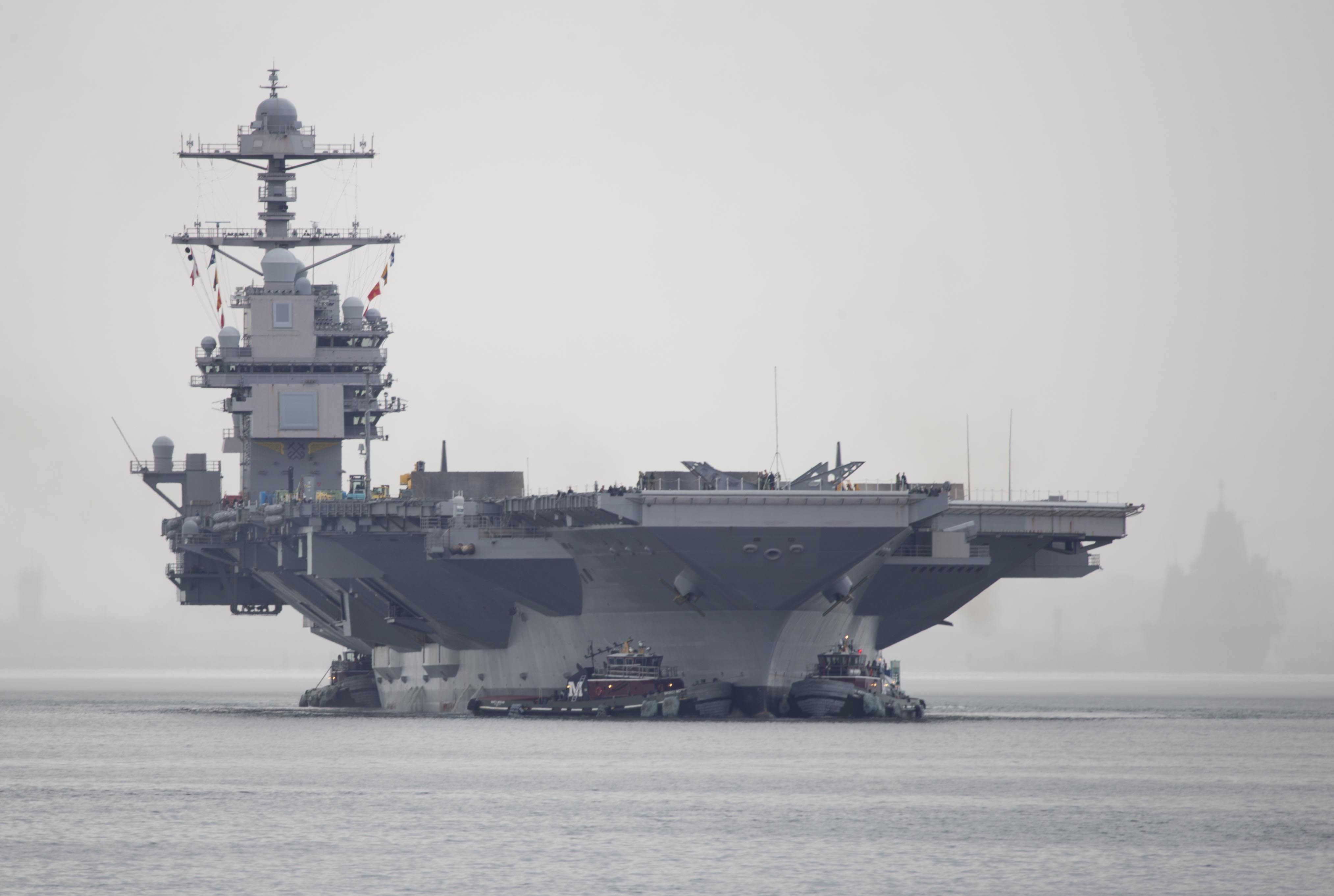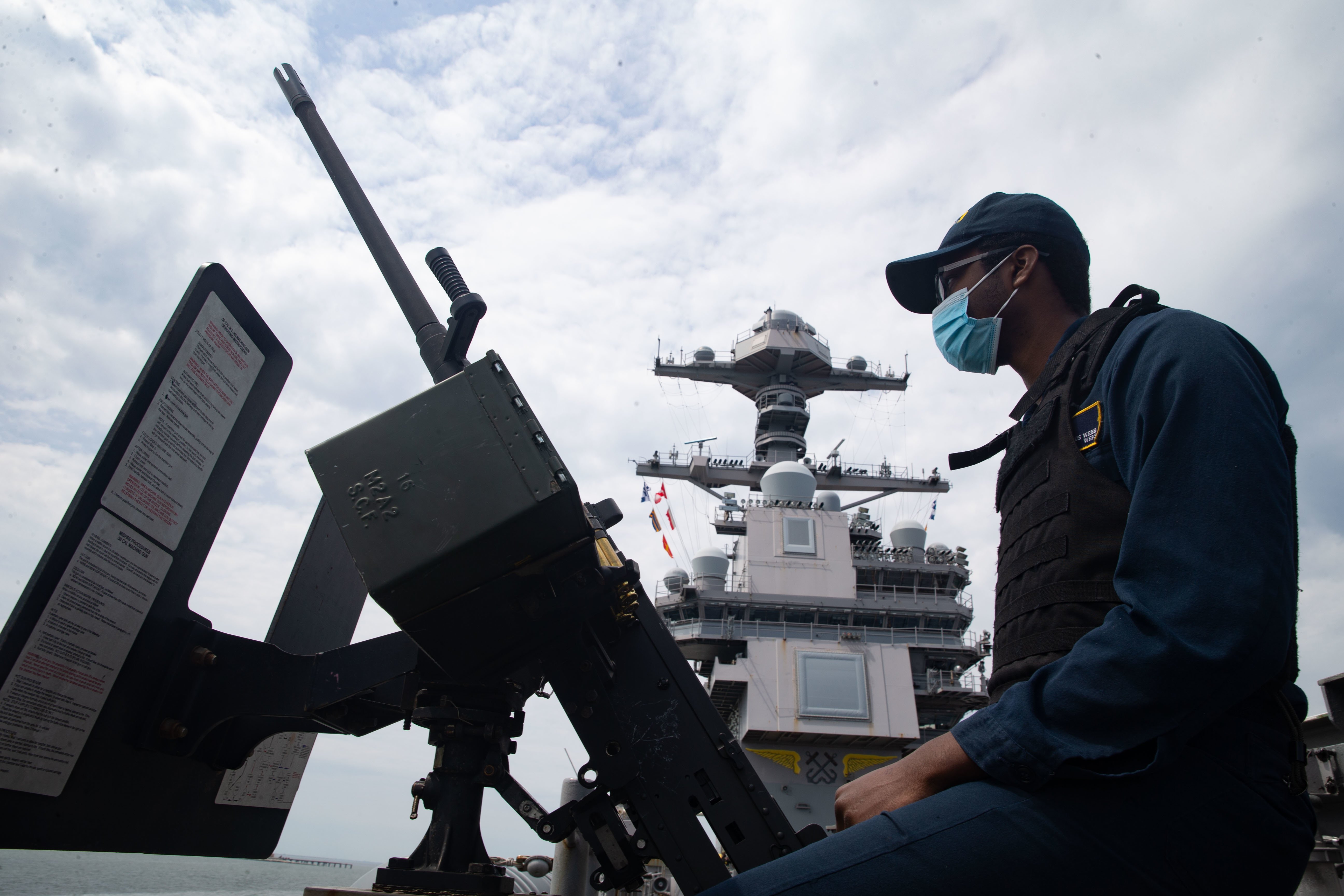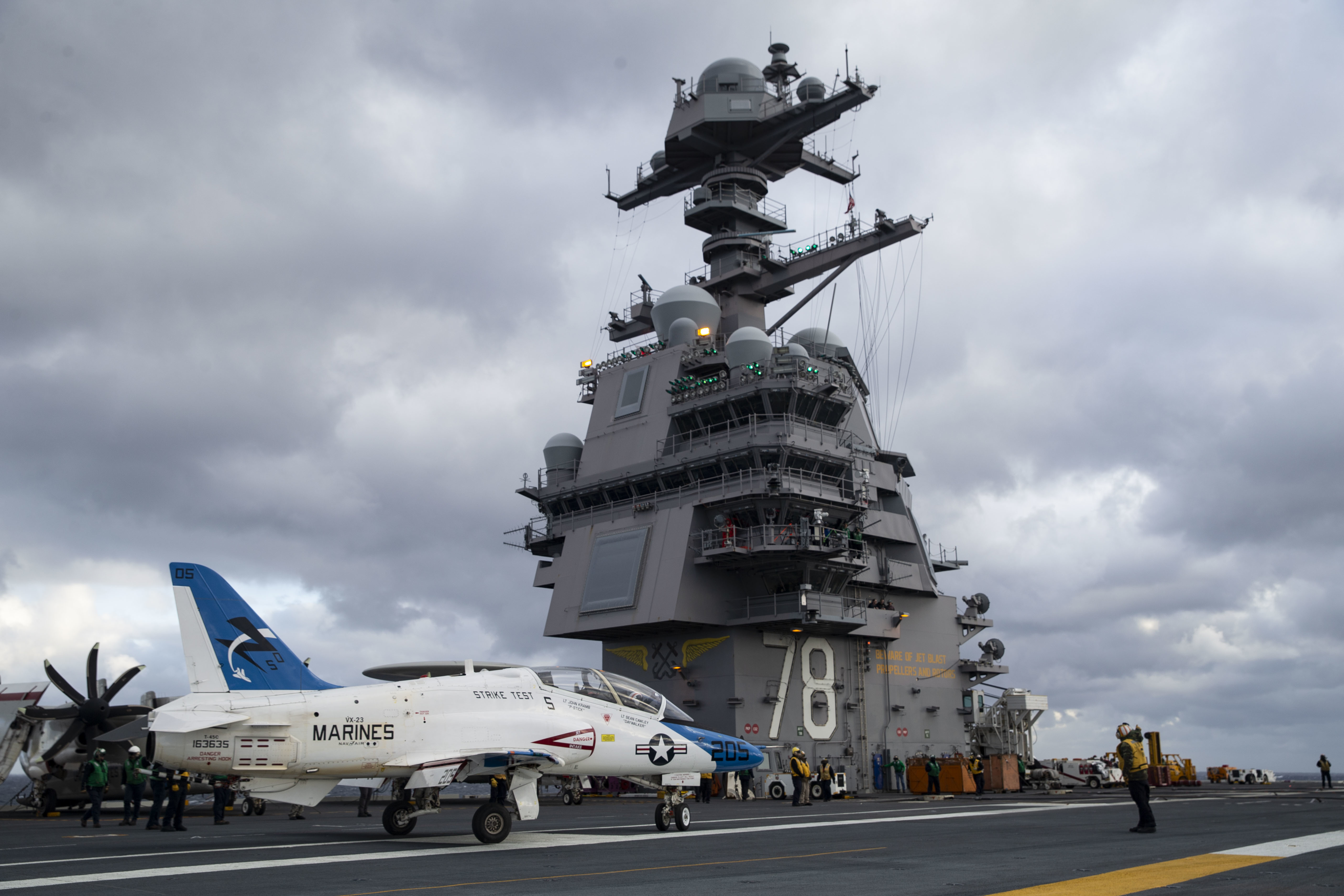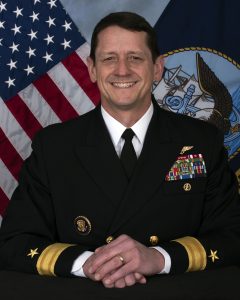
USS Gerald R. Ford (CVN-78) departed Naval Station Norfolk to transit to Newport News Shipbuilding in support of her Planned Incremental Availability (PIA), a six-month period of modernization, maintenance, and repairs, Aug. 20, 2021. US Navy Photo
The Navy is set to deploy USS Gerald R. Ford (CVN-78) for the first time in 2022, four years later than the original maiden deployment date of 2018.
After facing a series of delays and working out reliability problems with multiple new technologies, the $13 billion lead ship in the new Ford class of aircraft carriers is currently in the middle of the last maintenance phase ahead of its maiden deployment and will soon be available for Navy tasking.
“Everything is on track. We’re still looking to get out as scheduled after the six-month availability. No big show-stoppers that they’ve come across at all. So very, very positive news coming from the captain and from the shipyard. And then as we come out of that, I think we’re going to be set very well to get back in that operational mindset and get ready for the deployment,” Rear Adm. Gregory Huffman, the commander of Carrier Strike Group 12 who will lead the Ford CSG on its first deployment, told USNI News in a recent interview.
Fresh off a stint on the chief of naval operations staff, where he led operations and plans (N3) until June, Huffman recently had a front-row seat to the global force management that takes place in the Pentagon and how the Navy’s assets fit into the mix.
“Getting the Ford-class out there with its capabilities is basically just going to increase the number of carriers and carrier strike groups that we have available to meet the demands. And so that I think is just going to give us more flexibility,” Huffman said. “And then when you couple that with the projected increase in what the Ford should be able to do, that’s going to just provide the combatant commanders and other folks with just more options and more things at their fingertips that they can use.”
The promise of the Ford-class was to increase the sortie generation rate by about 30 percent, in part by having elevators that move ordnance up and down the rails with magnetic motors, as opposed to the cable elevators on the Nimitz class. Meanwhile, the Electromagnetic Aircraft Launch System (EMALS) can launch aircraft faster than the steam catapult system on the Nimitz class and requires less manning. The Advanced Arresting Gear, which catches fixed-wing aircraft when they land on the carrier, replaces the high-maintenance, hydraulic Mark 7 arresting gear. Both systems are dependent on software, which led to an EMALS fault aboard Ford last summer that halted flight operations for several days.
While the Navy’s carrier force has faced repeated strain over the last two decades, Huffman hopes that Ford’s addition to the fleet will help the service with its carrier supply and demand issue.
“Moving forward, getting the rest of the class constructed and out in an operational status I think is where we need to go in terms of keeping the carriers out there and realizing that persistent demand is not going away, at least in the near term,” Huffman said.

Seaman Saruis Webb, from Chicago, assigned to USS Gerald R. Ford’s (CVN-78) weapons department, stands an armed watch with an H-2B .50 caliber machine gun during sea and anchor on April 14, 2021. US Navy Photo
Huffman said his previous billet in the Pentagon showed him how the strain affects both naval assets and the sailors.
“That was one of the challenges was in order to meet that demand, the stress that winded up being placed on the fleet – both the material and more importantly the sailors – was really kind of palpable,” he said. “And so getting to see that, again kind of exemplifies a little bit of the urgency to get the Ford deployed and start taking our turn in the rotations of things. So that’s where I also get that perspective to it. But I did see that the stress that was being put on the fleet was very evident because of all the demands that are on the Navy.”
Ford has faced its share of problems, including issues with the Advanced Weapons Elevators, which carry ordnance to the flight deck and are a crucial part of increasing the sortie generation rate in the class. Huffman said the Navy is on track to have all 11 of the elevators complete by the time the current maintenance phase ends.
“Since they’ve had control over them, they’ve done over 15,000 cycles in all conditions. So it’s really positive from that aspect. The remaining four are on track to be turned over before the completion of the [planned incremental availability],” Huffman said of the carrier’s crew and the elevators. “We’re in a good spot to have all of that completed prior to completing the availability and prior to getting back out on operational point.”
The Navy finished the carrier’s summer shock trial events without any major flooding or fires, USNI News previously reported. During shock trials, the Navy detonates 40,000 pounds of ordnance in the water near the hull to test both the ship and its systems.

A T-45 Goshawk, assigned to Air Test and Evaluation Squadron (VX) 23, transits on USS Gerald R. Ford’s (CVN-78) flight deck. Ford is currently conducting Aircraft Compatibility Testing to further test its Electromagnetic Aircraft Launch Systems (EMALS) and Advanced Arresting Gear (AAG). US Navy Photo
Huffman said that while systems aboard Ford previously experienced some technological problems, the systems performed well during shock trials. For example, the ship had to perform a detect-to-engage sequence following each detonation.
“For the Dual Band Radar … after each one of the shocks there was a requirement to go out and do the test and tracking exercise. And they accomplished that every time. So that equipment performed very well – as well as the EMALS and [Advanced Arresting Gear]. So immediately after each of the shocks, they were able to get those things back up and running in an operational status in short order and meet the metrics that I think DOT&E was looking for,” Huffman said, referring to the Pentagon’s director of Operational Test & Evaluation (DOT&E), which over the years has identified reliability issues with the new systems aboard the ship.
To help prepare for the maiden deployment, the Navy brought the carrier strike commander and his staff aboard the ship during the 18-month post-delivery test and trials period, which ended in the spring just before full-ship shock trials. Putting the CSG commander on the carrier was not a typical move and it allowed the ship’s crew to get a head start on functions ranging from communications and operational drills to determining where the strike group staff would sleep.
“It gives us a leg up really in those fundamental sort of blocking and tackling things so that when we do get back out onboard, we’re going to be that much further ahead,” Huffman said. “We know what the communication pathways are. We know what the systems are. People know the basics on where they’re going to sleep and where they’re going to work and those type of things. So we’re not going to be starting from scratch on that.”
The carrier has yet to have a full air wing operate aboard, but will soon as it finishes the maintenance period and gears up for the deployment.
With an expected 50-year service life, Ford and the rest of the ships in the class will be part of the fleet as the Navy continues to pursue new unmanned platforms and charts a path forward for how to use and integrate the technology. Service officials have described Ford’s flexibility, like the modularity in various spaces aboard, as an asset that will help the carrier evolve with new technologies and missions.
“What the Ford really brings to the table is flexibility and adaptability because it was designed with changing technology in mind. So an example would be, the Nimitz class – very set in terms of what you have for a configuration onboard the ship itself and very challenging to change things when you have new technologies, new requirements coming down the line,” Huffman told USNI News.
“But the Ford is designed with more of that modular mindset. So it’s easier to adapt and flex as new equipment comes online, as we start looking at what new air wing composition is going to be and new technologies are presented, it will be much easier to incorporate that into the Ford and then get back into an operational status more rapidly than if we had to take an older ship and put it into a dry dock and completely reconfigure very, very fundamental aspects of the ship,” he added. “That would be very challenging. But the Ford is going to give us the ability to adapt more quickly, I think. So that’s part of why it’s just going to be very important for us to get them out and operational and get on point with it.”

